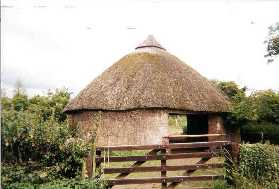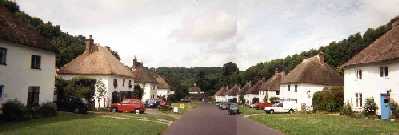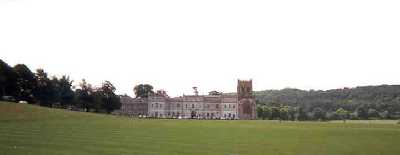Second stage
The ride continued on the A31 and then on a country lane into Anderson.

|
Some miles further down the road we entered Winterborne Kingston, were some fine examples of rural Dorset architecture can be found (see the picture of a round barn on the side). As a matter of fact, there are fifteen villages in Dorset which are prefixed by Winterborne, which according to my Collins Dictionary means "...a stream flowing only after heavy rainfall, especially in winter". Winterborne Kingston is notable due to the medieval church of St Nicholas. For those of you who are avid campanologists a description of the bell ring is given at this Dorset Churches web site. A National Lottery grant was recently granted by the Millenium Commission and administered by the Association of Bell Ringers towards their restoration. The bells are played every Wednesday evening at 7:30 in the evening. You can listen to their ring by clicking on this link (you will need RealAudio player).
|
The next village was Winterborne Whitechurch, on the junction of the A345 road. Following some very steep slopes and beautiful summer fields I reached the top of the hill. I overtook other participants riding ordinary push bikes. Since it was hard for me on my mountain bike, I guess that it must have been exhausting for them. Milton Abbas now stretched before me along the downhill road.

The view was magnificent. I stopped for a second to catch my breath again, both because of the effort and the beauty of the view. The wooded slopes loomed behind the cottages and the the sun was making a timid appearance. This village and neighbouring abbey merited a separate page which you can read by clicking here.

Riding along the school I could see cars parked outside the school, possibly attending an academic function. The road then continued on the sides of the hills towards Hilton. This village is known to me as the place where my friend Norman Aish keeps his 1950 Bedford coach. Norman runs a small vintage vehicle spare parts business in Poole, particularly Bedford 1950's coaches. He looks after his coach with great care, so much so that it gets first-class accommodation in the Hilton village!!
The local Hilton church contains objects sent from Milton Abbey during the Dissolution of the Monasteries in the 1530's.
At this point the course of the ride turned South, signalling that we were approaching the end of its first half. We were passing Ansty, where the most outstanding feature is the manor house, Bingham's Melcombe near Higher Ansty. The house belonged to the Bingham family (predictably enough) from the 13th century until 1895. The local church was mostly erected in the 14th century, and in the 16th century the local vandals of the time painted graffiti which remains to our day - there is very little new under the sun...
The next village was Cheselbourne, again named after a water stream (for example, Bournemouth means the mouth of a stream, alas a spring). It was time for a bite. I had been riding for quite some time and I was getting hungry. Other participants rode past while I sat by the side of the road to enjoy my sandwiches and refreshments.
No concession to lazyness was made and I restarted the course immediately. Some more miles and I was already heading towards Dorchester, the capital of Dorset county. Dorchester was a Roman city in 100 A.D., although little remains apparent from those days. The Dorset County Museum keeps a number of Roman mosaics.
We did not go into Dorchester but surronded the town on its by-pass road, and turning left at the A35 I reached the Dorchester Check Point. A new stamp on my card certified that I was on my way to completing the course. The third and last stage of the ride awaited.
Click below to go to the third stage.

Third stage



